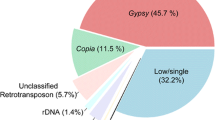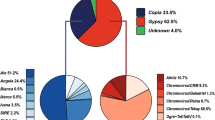Abstract
A real-time PCR approach was adopted and optimized to estimate and compare, through a relative quantification, the copy number of WIS2-1A and BARE-1 retrotransposons. The aim of this approach was to identify and quantify the presence of these retrotransposons in Triticum and Aegilops species, and to understand better the genome organization of these retroelements. The species were selected to assess and compare the evolution of the different types of genomes between the more recent species such as the diploid Triticum monococcum, tetraploid T. dicoccon and hexaploid T. spelta, and the corresponding genome donors of the ancient diploids Aegilops (Ae. speltoides, Ae. tauschii, Ae. sharonensis and Ae. bicornis) and T. urartu. The results of this study indicated the presence of great variation in copy number both within and among species, and the existence of a non-linear relationship between retrotransposon copy number and ploidy level. For WIS2-1A, as expected, T. monococcum showed the lowest copy number which instead was similar in T. dicoccon and T. spelta; also T. urartu (AA), Ae. speltoides (BB) and Ae. tauschii (DD) showed a higher WIS2-1A copy number. Similar results were observed for BARE-1 retroelements except for Ae. tauschii which as in T. monococcum showed lower retroelements content; a similar content for T. dicoccon and T. urartu, whereas a higher number was found in T. spelta and Ae. speltoides. The results presented here are in accord with previous studies and contribute to unravelling the structure and evolution of polyploidy and repetitive genomes.




Similar content being viewed by others
References
Barakat A, Carels N, Bernardi G (1997) The distribution of genes in the genomes of Gramineae. P Natl Acad Sci USA 94:6857–6861
Bennett M, Smith J (1976) Nuclear DNA amounts in angiosperms. Philos Trans R Soc B 274:227–274
Bennetzen J (2000) Transposable elements contributions to plant gene and genome evolution. Plant Mol Biol 42:251–269
Charles M, Belcram H, Just J, Huneau C, Viollet A, Couloux A, Segurens B, Carter M, Huteau V, Coriton O, Appels R, Samain S, Chalhoub B (2008) Dynamics and differential proliferation of transposable elements during the evolution of the B and A genomes of wheat. Genetics 180:1071–1086
Devos KM, Brown JKM, Bennetzen J (2002) Genome size reduction through illegitimate recombination counteracts genome expansion in Arabidopsis. Genome Res 12:1075–1079
Dvorak J, McGuire P, Cassidy B (1988) Apparent sources of the A genomes of wheats inferred from polymorphism in abundance and restriction fragment length of repeated nucleotide sequences. Genome 30:680–689
Dvorak J, Di Terlizzi P, Zhang HB, Resta P (1993) The evolution of polyploid wheats: identification of A genome donor species. Genome 36:21–31
Flavell A, Smith D, Kumar A (1992) Extreme heterogeneity of Ty1-copia group retrotransposons in plants. Mol Genet Genomics 231:233–242
Furuta Y, Nishikawa K, Yamaguch S (1986) Nuclear DNA content in diploid wheat and its relatives in relation to the phylogeny of tetraploid wheat. Jpn J Genet 61:97–105
Gribbon B, Pearce S, Kalendar R, Schulman A, Paulin L, Jack P, Kumar A, Flavell A (1999) Phylogeny and transpositional activity of Ty1-copia group retrotransposons in cereal genomes. Mol Genet Genomics. 261:883–891
Gu YQ, Salse J, Coleman D, Dupen A, Crossman C, Lazo G, Huo N, Belcram H, Ravel C, Charmet G, Charles M, Anderson O, Chalhoub B (2006) Types and rates of sequence evolution at the high-molecular-weight glutenin locus in hexaploid wheat and its ancestral genomes. Genetics. 174:1493–1504
Gynheung A, Dong-Hoon J, Ki-Hong J, Sichul L (2005) Reverse genetic approaches for functional genomics of rice. Plant Mol Biol 59:111–123
Harberd N, Flavell R, Thompson R (1987) Identification of a transposon- like insertion in a Glu-1 allele of wheat. Mol Genet Genomics 209:326–332
Hirochika H, Sugimoto K, Otsuky Y, Tsugawa H, Kanda M (1996) Retrotransposons of rice involved in mutations induced by tissue culture. Proc Natl Acad Sci USA 93:7783–7788
Jianxin M, Devos KM, Bennetzen JL (2004) Analyses of LTR-retrotransposon structure reveal recent and rapid genomic DNA Loss in rice. Genome Res 14:860–869
Kalendar R, Grob T, Regina M, Suoniemi A, Schulman A (1999) IRAP and REMAP: two new retrotransposon-based DNA fingerprinting techniques. Theor Appl Genet 98:704–711
Kalendar R, Tanskanen J, Immonen S, Nevo E, Schulman A (2000) Genome evolution of wild barley (Hordeum spontaneum) by BARE-1 retrotransposon dynamics in response to sharp microclimatic divergence. P Natl Acad Sci USA 97:6603–6607
Katsiotis A, Schmidt T, Heslop-Harrison J (1996) Chromosomal and genomic organization of Ty1-copia-like retrotransposon sequences in the genus Avena. Genome 39:410–417
Kirchner J, Connolly CM, Sandmeyer SB (1995) Requirement of RNA-polymerase-III transcription factors for in-vitro position-specific integration of a retrovirus-like element. Science 267:1488–1491
Kronmiller BA, Wise RP (2008) TEnest: automated chronological annotation and visualization of nested plant transposable elements. Plant Physiol 146:45–59
Kumar A, Bennetzen J (1999) Plant retrotransposons. Annu Rev Genet 33:479–532
Levy A, Feldman M (2002) The impact of polyploidy on grass genome evolution. Plant Physiol 130:1587–1593
Li W, Zhang P, Fellers J, Friebe B, Gill B (2004) Sequence composition, organization and evolution of the core Triticae genome. Plant J 40:500–511
Liu R, Vitte C, Ma J, Mahama AA, Dhliwayo T, Lee M, Bennetzen JL (2007) A GeneTrek analysis of the maize genome. Proc Natl Acad Sci USA 104:11844–11849
Lucas H, Moore G, Murphy G, Flavell R (1992) Inverted repairs in the long-terminal repeats of the wheat retrotransposon WIS2-1A. Mol Biol Evol 9:716–728
Manninen I, Schulman A (1993) BARE-1, a copia-like retroelement in barley (Hordeum vulgare L.). Plant Mol Biol 22:829–846
Martin C, Prescott A, Lister C, Mackay S (1989) Activity of the transposon Tam3 in Antirrhinum and tobacco: possible role of DNA methylation. EMBO J 8:997–1004
Meyers BC, Tingey SV, Morgante M (2001) Abundance, distribution and transcriptional activity of repetitive elements in the maize genome. Genome Res 11:1660–1676
Monte J, Flavell R, Gustafson J (1995) WIS2-1A: an ancient retrotransposon in the Triticae tribe. Theor Appl Genet 91:367–373
Moore G, Lucas H, Batty N, Flavell R (1991) A family of retrotransposons and associated genomic variation in wheat. Genomics 10:461–468
Ozkan H, Tuna M, Arumuganathan K (2003) Non-additive changes in genome size during allopolyploidization in the wheat (Aegilops–Triticum) group. J Heredity 94(3):260–264
Panstruga R, Buschges R, Piffanelli P, Schulze-Lefert P (1998) A contiguous 60 kb genomic stretch from barley reveals molecular evidence for gene islands in a monocot genome. Nucleic Acids Res 26:1056–1062
Ramakrishna W, Dubcovsky J, Park YJ, Busso C, Emberton J, SanMiguel P, Bennetzen J (2002) Different types and rates of genome evolution detected by comparative sequence analysis of orthologous segments from four cereal genomes. Genetics 162:1389–1400
Sabot F, Guyot R, Wicker T, Chantret N, Laubin B, Chalhoub B, Leroy P, Sourdille P, Bernard M (2005) Updating of transposable element annotations from large wheat genomic sequence reveals diverse activities and gene associations. Mol Genet Genomics. 274:119–130
Smith D, Flavell A (1975) Characterisation of the wheat genome by renaturation kinetics. Chromosoma 50:223–242
Soleimani VD, Baum BR, Johnson DA (2006) Quantification of the retrotransposon BARE-1 reveals the dynamic nature of the barley genome. Genome 49:389–396
Suoniemi A, Anamthawat-Jonsson K, Arna T, Schulman A (1996) Retrotransposon BARE-1 is a major, dispersed component of the barley (Hordeum vulgare L.) genome. Plant Mol Biol 30:1321–1329
Suoniemi A, Schmidt D, Schulman AH (1997) BARE-1 insertion site preferences and evolutionary conservation of RNA and cDNA processing sites. Genetica 100:219–230
Vicient C, Suoniemi A, Anamthawat-Jonsson K, Tanskanen J, Beharav A, Nevo E, Schulman A (1999) Retrotransposon BARE-1 and its role in genome evolution in the genus Hordeum. Plant Cell 11:1769–1784
Voytas D, Cummings M, Konieczny A, Ausubel F, Rormel S (1992) Copia-like retrotransposons are ubiquitous among plants. Proc Natl Acad Sci USA 89:7124–7128
Wanlong L, Peng Z, Fellers JP, Friebe B, Gill BS (2004) Sequence composition, organization, and evolution of the core Triticae genome. Plant J 40:500–511
Waugh R, McLean K, Flavell A, Pearce S, Kumar A, Thomas B, Powell W (1997) Genetic distribution of BARE-1-like retrotransposable elements in the barley genome revealed by sequence-specific amplification polymorphisms (S-SAP). Mol Genet Genomics 253:687–694
Wendel J (2000) Genome evolution in polyploids. Plant Mol Biol 42:225–249
Whitford R, Baumann U, Sutton T, Gumaelius L, Wolters P, Tingey S, Able J, Langridge P (2007) Identification of transposons, retroelements, and a gene family predominantly expressed in floral tissues in chromosome 3DS of the hexaploid wheat progenitor Aegilops tauschii. Funct Integr Gen 7:37–52
Wicker T, Yahiaoui N, Guyot R, Schlagenhauf E, Zhong-Da L, Dubcovsky J, Keller B (2003) Rapid genome divergence at orthologous low molecular weight glutenin loci of the A and Am genomes of wheat. Plant Cell 15:1186–1197
Acknowledgments
Authors acknowledge the financial support of the Italian Ministry of University, the contribution of Drs A. Brandolini, O. Porfili and P. Codiani for the provision of germplasm samples, and Dr. R. Koebner for his useful suggestions in editing the manuscript.
Author information
Authors and Affiliations
Corresponding author
Additional information
Communicated by R. Hagemann.
Rights and permissions
About this article
Cite this article
Pagnotta, M.A., Mondini, L. & Porceddu, E. Quantification and organization of WIS2-1A and BARE-1 retrotransposons in different genomes of Triticum and Aegilops species. Mol Genet Genomics 282, 245–255 (2009). https://doi.org/10.1007/s00438-009-0462-6
Received:
Accepted:
Published:
Issue Date:
DOI: https://doi.org/10.1007/s00438-009-0462-6




